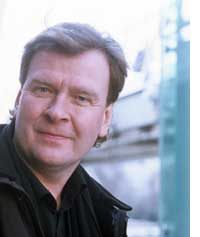Magnus Lindberg: interview about choral/orchestral GRAFFITI

Magnus Lindberg: interview on choral/orchestral GRAFFITI
Magnus Lindberg’s first work for choir and orchestra, GRAFFITI, was premiered in Helsinki in May, and receives its UK premiere by the Philharmonia Orchestra and Esa-Pekka Salonen on 1 October.
What were the origins of GRAFFITI?
I’ve been toying with the idea of writing an opera for close on 20 years, and I’m still not clear how best to achieve this. However, a good result of this quest was that I began to investigate possible texts that don’t necessarily have a plot, but could be moulded into a personalised dramatic structure. This is what led to GRAFFITI because I was drawn to texts that could provide interesting angles on everyday life, that might be assembled like a mosaic of ideas and observations. Anything that requires wordsetting immediately asks the question ‘which language?’ I decided against Finnish or Swedish, and English has all sorts of special challenges, so I started exploring Latin texts because of their remoteness.
How did you select the texts?
Once I opted for Latin inscriptions rather than poetry I was staggered by the scale of what was available. I spent three months sifting through the sources, particularly in the Corpus Inscriptionum Latinarum. The next decision was to concentrate on inscriptions from the excavated city of Pompeii, as they offered such a unique and intact glimpse into a 2000 year-old society that suddenly ceased to exist. Pompeii also offered the variety I needed for a large-scale work, with so many aspects of life described on so many levels, from the banal to the philosophical, from domestic activities to political and civic life.
What was your approach in creating a living world from a dead language?
I soon realised that the context of the graffiti was very important to understanding them and I was very fortunate to have Professor Paavo Castrén as a guide to Roman life at that time. He led excavation projects at Pompeii undertaken by Helsinki University and is an expert on the classical world. Not only did he explain what was behind the graffiti, but we began discussing how the words might have been pronounced, which was important in terms of composing the vocal lines. Of course, no-one can know for sure about Roman pronunciation, and there are distinct schools of thought on this, but I wanted to make the text come alive as much as possible, rather than sound distanced and archaic – perhaps this makes my approach different to Stravinsky’s arms-length usage of Latin texts. I set the graffiti as closely as possible, with all their colloquialisms, misspellings and bad grammar.
How did the musical shape develop?
The first step was building a musical schedule based on the texts. When I‘d organised the inscriptions into groups based on subject matter, for example about gladiators or love-life, types of music emerged, and the collision between these created the large-scale structure. To sum the piece up it’s about huge contrasts, with clashes of mood and expression, and a dynamic dialogue between text and music. Though I wanted to be faithful to the texts I was under no illusion that I was creating an archaic work, so I don’t approximate to a historical ‘Roman’ sound and am quite comfortable using a contemporary orchestra including percussion instruments like a vibraphone.
Were there particular models for the work?
Well, the starting point was inevitably the combination of choir and orchestra in the Latin works by Stravinsky, particularly the Symphony of Psalms and Oedipus Rex, together with the earthy flavour of Les Noces - these are all iconic works for me as a composer. But there are also more modern works which pointed to a way of writing for voices ‘within’ an orchestra, such as Berio’s Coro and Passaggio. I tend to favour this approach where the voices are often treated in an instrumental fashion, so choral and orchestral sounds are fused.
This is your first large-scale choral work.
Yes, and that has led me to try and find parallels in the choral writing to my orchestral techniques. Sometimes the choir sings in homophonic blocks, sometimes solo and duet lines emerge, and at other times there are ‘chamber music-like’ choral divisi up to 16 voice parts. I wanted to match the harmonic style to the texts, so the vocal soundworld could be martial and gladitorial, bawdy and licentious, or sinuously erotic. I have found few works where atonal choral writing truly succeeds (Ligeti is a rare example), so my harmonies here are more modal and tonal than in many of my pieces, and this lends a distinct flavour which helps project the immediacy of the everyday life stories in the graffiti.
Interviewed by David Allenby
Listen to an audio clip of GRAFFITI
> Further information on Work: GRAFFITI
Photo: Hanya Chlala/ArenaPAL
